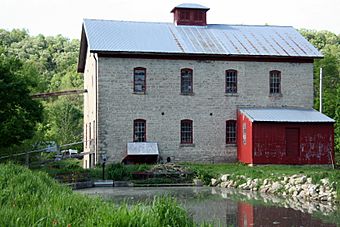Schech's Mill facts for kids
Quick facts for kids |
|
|
Schech Mill
|
|

Schech's Mill in 2011
|
|
| Nearest city | Caledonia, Minnesota |
|---|---|
| Built | 1875 |
| NRHP reference No. | 78001548 |
| Added to NRHP | January 31, 1978 |
Schech's Mill is a very old and special mill located in Houston County, Minnesota, United States. It's a historic place that still works today, just like it did many years ago. This mill is one of only three watermills in Minnesota that still use only water power to operate. What makes it even more unique is that it's the only one that still has its original millstones.
Schech's Mill was added to the National Register of Historic Places on January 31, 1978. This means it's recognized as an important historical site worth protecting.
Contents
What is Schech's Mill?
Schech's Mill is a type of mill that uses the power of flowing water to grind grains. It's often called a watermill. The mill has large, heavy stones called millstones that spin and crush grains into flour or meal.
A Look Back: The Mill's History
The mill was first built in 1876 by a person named John Blinn. A little later, a miller from Minneapolis named Michael Schech bought it. Michael Schech had moved to the United States from Bavaria, Germany. He continued the work of grinding grains at the mill.
For many years, Schech's Mill produced different kinds of flour and cereal. These included cornmeal, rye buckwheat, wheat flour, graham flour, and whole wheat cereal. These products were sold to people in nearby towns like Caledonia and Houston, Minnesota.
How the Mill Works
Schech's Mill is special because it still has its original machinery from the 1870s. This equipment is still in working order! During that time, new tools like the "middlings purifier" were being used. This tool helped make flour even finer. However, the mill still used traditional millstones, which were later replaced by newer "roller mills" in other places. In 1922, the original wooden dam that helped power the mill was replaced with a stronger concrete one.
Where is Schech's Mill Located?
Schech's Mill is found in an interesting area called the Driftless Area. This region in the American Midwest is known for its deep river valleys. It's a beautiful place with unique landscapes.
Visiting Schech's Mill
If you're interested in seeing history come to life, you can visit Schech's Mill! Private tours can be set up on most summer weekends. During these tours, you can watch a real demonstration of how flour is ground using the mill's historic machinery. It's a great way to learn about how people used to make food and what life was like long ago.



